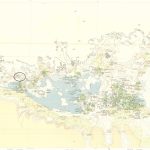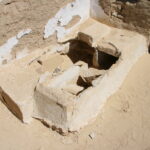BILĀD AL-RŪM
| Arabic | بلاد الروم |
| DEChriM ID | 69 |
| Trismegistos GeoID | 61707 |
| Pleiades ID | - | PAThs ID | - |
| Ancient name | - |
| Modern name | Bilād al-Rūm |
| Latitude | 29.228000 |
| Longitude | 25.407194 |
| Date from | 350 |
| Date to | 500 |
| Typology | Cemetery |
| Dating criteria | Text content and onomastics of the stelae. |
| Description | The site is located in the western region of Sīwa Oasis, to the west of Ḫamīsa. The region includes a cemetery comprising numerous rock-cut graves dating from the Greco-Roman period (the area of interest), in addition to the remains of a mud-brick building at the foot of the mountain, and, further south, the remains of the so-called ‘Doric Temple’, dating from the first century CE, and a quarry. The mud-brick structure is considered by the inhabitants to have been a church, though the only support of this claim is the Siwan Manuscript, “a 19th century writ preserving a mixture of Arab literary sources on Siwa and oral traditions about local history and law”, which states that the area around the church was inhabited by “women of ill-repute” (Kuhlmann 1998: 174-175; Stanley 1911: 35-41; Fakhry 1944: 69, fig. 2; id 1973: 39; Bliss 1985: 108-31; Ghica 2012: 266). These ruins, known as Kasr el-Roum, or ‘El-Amoudein’ by Rohlfs, have also been considered to have been a Roman camp or a mausoleum (Rohlfs 1871: 92; Fakhry 1973, 90, 126, n. 2; Al-Dumayrī 2005: 138; id 2007: 61; Ghica 2012: 268). Fakhry included a photograph of this structure in his earlier work (Fakhry 1944, pl. ix). According to the local Egyptian inspectors, c. 150 rock-cut tombs in the mountain were inventoried, in addition to a number of built tombs at the foot of the mountain. These later tombs included poorly mummified human remains which were both interred in the ground and simply placed on the floor. Three funerary stelae were found in one of these later structures (see artefacts), repurposed from earlier architectural elements, which contained explicitly Christian content, indicating that these were in fact the tombs of Christians (Al-Dumayrī 2005: 144-146, figs. 1 and 2; Al-Dumayrī 2007: 60-61, figs. 54-57; Ghica 2012: 267). Although the Christian presence in Sīwa is known via texts, with, among others, heretical bishops from the Thebaid sent there in the fourth-century and exiles already in the third century (Ghica 2012: 264), this is the first archaeological evidence documenting a Christian community (Ghica 2012: 264, n. 460). The earliest textual evidence of a bishopric derives from a recently identified source, the Historia Episcopatus Alexandriae, dated to the late fourth century (Ghica 2012: 265, n. 466 and 467). The text, preserved in Ethiopic, mentions two bishops of Ammōniakē (Sīwa), Ṗaṭaroqālos and Ṗa(n)filos (Bausi, Camplani 2016: 275), both ordained by Theonas, pope of Alexandria between 282 and 300. |
| Archaeological research | The site was visited by numerous early travellers with brief notes included in their travellogues, including William G. Browne, who ‘discovered’ the so-called ‘Doric Temple’ in 1792 (Browne 1799: 27), accompanied by the likes of F. Cailliaud in 1819 (Cailliaud 1826: 72), H. F. V. Minutoli in 1820 (Minutoli 1824: 173), G. Rohlfs 1869 (Rohlfs 1871: 92) and G. Steindorff (Steindorff, 1904: 126). Fakhry visited the site in the 1940s and included references in two works (1944 and 1975). Most of the archaeological interest in the area has focused on the ‘Doric Temple’. A Greek misison, directed by Liana Souvaltzi, began excavating the temple in 1989, and in 1995 the claim was made that it was the burial place of Alexander the Great, leading to much controversy and eventually the revocation of the team’s permission to conduct excavations in Egypt. The misison did, however, reveal fragments of a large Greek inscription dating to the reign of Hadrian (Nur el-Din 1995: 45-46; Kuhlmann 1998: 164). The only archaeological work known to have taken place in the actual funerary area was that of the SCA, with work conducted between 1997 and 2001, under the direction of al-Dumayrī (Al-Dumayrī 2005; id 2007). A ceramic prospection was conducted in March 2009 by V. Ghica and D. Dixneuf, as part of a larger survey of Sīwa, in the hopes of clarifying dating elements related to the ‘Christian’ tomb, but none were able to be identified (Ghica 2012: 267). |
• Al-Dumayrī, A. A. 2005. سيوة الماضي والحاضر. Alexandria: Yasso.
• Aldumairy, A. A. 2007. L’Oasis de Siwa: d’hier à aujourd’hui, 60-61. Alexandria: Yasso.
• Bausi, A. and Camplani, A. 2016. “The History of the Episcopate of Alexandria (HEpA): Editio minor of the fragments preserved in the Aksumite Collection and in the Codex Veronensis LX (58).” Adamantius 22: 249-302.
• Belgrave, Ch. D. 1923. Siwa. The Oasis of Jupiter Ammon. London: John Lane.
• Bliss, F. 1985. “Sitte und Recht in Siwa (Westliche Wüste Ägyptens).” Der Islam 62: 108-131.
• Browne, W. G. 1799. Travels in Africa, Egypt and Syria, from the Year 1792 to 1798. London: Printed for T. Cadell junior and W. Davies, Strand ; And T.N. Longman and O. Rees, Paternoster-Row
• Bruhn, K.-C. 2010. Kein Tempel der Pracht: Architektur und Geschichte des Tempels aus der Zeit des Amasis auf Aġūrmī, Oase Siwa. Wiesbaden: Otto Harrassowitz.
• Cailliaud, F. 1826. Voyage à Méroé, au fleuve blanc, au-delà de Fâzoqi dans le midi du Royaume de Sennâr, à Syouah et dans cinq autres oasis; fait dans les années 1819, 1820, 1821 et 1822, tome I et II. Paris: Imprimerie Royale.
• Fakhry, A. 1944. Siwa Oasis: Its History and Antiquities. Cairo: Government Press.
• Fakhry, A. 1973. Siwa Oasis. Cairo: American University in Cairo Press.
• Ghica, V. 2012. “Pour une histoire du christianisme dans le désert Occidental d’Égypte.” Journal des savants 2: 264-268.
• Kuhlmann, K. P. 1988. Das Ammoneion: Archäologie, Geschichte und Kultpraxis des Orakels von Siwa. Mainz am Rhein: Philipp von Zabern.
• Kuhlmann, K. P. 1998. “Roman and Byzantine Siwa: Developing. Latent Picture.” In Life on the Fringe. Living in the Southern Egyptian Deserts during the Roman and Early-Byzantine Periods. Proceedings of a Colloquium Held on the Occasion of the 25th Anniversary of the Netherlands Institute for Archaeology and Arabic Studies in Cairo 9-12 December 1996, edited by O. E. Kaper, 159-180. Leiden: Research School CNWS.
• Minutoli, H. F. V. 1824. Reise zum Tempel des Jupiter Ammon in der Libyschen Wüste und nach Ober-Aegypten in den Jahren 1820 und 1821. Berlin: August Rücker.
• Nur el-Din, M. A. H. 1995. "Eine wichrige archäologische Entdeckung. Bericht vom 7.3.95 über die Ausgrabung einer griechischen Expedition in al-Maraqi bei Siwa.” Kemet April: 45-46
• Rohlfs, G. 1871. Von Tripolis nach Alexandrien : Beschreibung der im Auftrage Sr. Majestät des Königs von Preussen in den Jahren 1868 und 1869 ausgeführten Reise, Vol. 2. Bremen: Kühtmann.
• Stanley, C. V. B. 1911. A Report on the Oasis of Siwa. Cairo: Egyptian Government, The Department of Health.
• Steindorff, G. 1904. Durch die Libysche Wüste zur Amonsoase. Bielefeld [u.a.]: Velhagen & Klasing.
• Wagner, G. 1987. Les Oasis d’Égypte à l’époque grecque, romaine et byzantine d’après les documents grecs: Recherches de papyrologie et d’épigraphie grecques. Cairo: Institut français d’archéologie orientale.


 Json data
Json data







